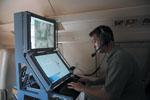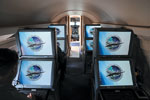Airborne Electronics Testbed Keeps Military Exercise Plugged In
 |
Airborne Multi-INT Laboratory (AML) is a modified Gulfstream G3 business jet equipped with reconfigurable array sensors and data links. Developed by Lockheed Martin, the AML is a plug and play platform that allows a variety of systems to be mixed and tested to meet customer needs. |
An innovative flying laboratory collected and distributed data across a simulated battlefield network as part of a major U.S. Army communications and networking exercise held in August. Designed to be rapidly reconfigured to carry a variety of software and sensors, the aircraft facilitates analysis of the best mix of equipment and personnel before flying command and control platforms are developed.
The Airborne Multi-INT Laboratory (AML) is housed in a Gulfstream G3 business jet modified to carry sensors and equipment. The goal of the laboratory is to create a plug-and-play platform that allows a variety of systems to be mixed and tested to meet customer needs, explains James E. Quinn, vice president of Lockheed Martin’s C4ISR (command, control, communications, computers, intelligence, surveillance and reconnaissance) systems, Bethesda, Maryland. Lockheed Martin developed the AML.
Lockheed Martin has spent most of this year finalizing the software and equipment build-out of the aircraft. The AML received its Experimental Airworthiness Certificate from the Federal Aviation Administration in August. The first event for the AML was the Army’s C4ISR On The Move experiment held in August at Lakehurst and
Quinn explains that the company’s design team worked to determine the ideal mix of operator workstations in the aircraft. Lockheed Martin engineers also pondered the appropriate configuration of onboard processors and datalinks to manage and transmit C4ISR information to users on the ground. He notes that these various links can be high-bandwidth satellite terminals or air-to-ground radios. Depending on mission or customer needs, the AML also can host infrared, electro-optical, radio frequency or radar systems.
A “canoe” on the underside of the aircraft can house a synthetic aperture radar or other sensors. Quinn explains that the AML’s hardware and electronic bus system allow sensors and software to be installed and swapped quickly. The flying laboratory’s architecture then fuses the data collected from the onboard sensors into a coherent picture for users both in the aircraft and on the ground.
The AML was developed under a cooperative research and development agreement (CRADA) between Lockheed Martin and the Army, explains Charles Maraldo, a special projects manager with the Army’s Intelligence and Information Warfare Directorate (I2WD),
Maraldo notes that the AML is not an Army program, but a Lockheed Martin business development project designed to showcase the company’s ability to integrate sensors and systems onto airborne platforms. Under a CRADA, the services cooperate with industry partners in developing, testing and demonstrating technology solutions. The Army and companies also can share data and limited data rights under the agreement.
 |
 |
The AML features four workstations that can be used to monitor onboard sensors, track data feeds, or to simulate and test command, control, communications, computers, intelligence and reconnaissance capabilities. |
This information is being used to help the I2WD to develop new intelligence products, sensor fusion algorithms and to demonstrate that data from various types of ISR platforms can be developed rapidly into a finished intelligence product that is useful to the edge of the battlefield. Some of the communications equipment deployed at the event consisted of datalinks to move information between the airborne platforms. Maraldo notes that platforms such as the AML helped to thicken the C4ISR picture during the exercise by providing more robust data feeds from a variety of sensors. “We can show that there are things that we can do today that are currently not being done that can provide some real value,” he shares.
Data from the AML, such as signals intelligence and feeds from radar and electro-optical sensors, was fused and integrated at the network level in real- and near-real time. The I2WD provided some sensors and electronic warfare capabilities for the event, and additional sensors also were deployed on Army helicopters flying out of
This stream of situational awareness data was formatted into reports that were pushed across the C4ISR On The Move network and made available to command and control systems during the demonstration. The Army’s Communications-Electronics Research, Development and Engineering Center (CERDEC) network managed the exercise. Data was sent to warfighters at the tactical level via vehicle-mounted command and control terminals and handheld battle management devices.
The network architecture created for the event enabled specific sensor types to be used more efficiently. For example, the enhanced C4ISR systems at the event allowed sensors with narrow fields of view, such as cameras and infrared and electro-optic systems, to be more accurately focused on potential threats. “We’re attempting to show the value of those types of feeds,” Maraldo maintains.
The Army also has begun discussions with Lockheed Martin to fly sensors on the AML in future experiments as part of the CRADA. Maraldo stresses that the relationship with Lockheed Martin is good, but not exclusive. He adds that I2WD works with contractor firms across all mission areas such as electronic warfare and communications. He cites the work with Lockheed Martin as the type of relationship that the I2WD is promoting with industry to help advance the state of the art. By cooperating, both sides benefit, he emphasizes. If Lockheed Martin shows that it can integrate competing vendor equipment, that is good for the company. “If we can show that we are able to fly economically on platforms that provide a certain flight profile or capability, that’s good for us,” he says, adding that potential for this type of work exists across industry. This research is not industry specific. The goal, he says, is to use existing technology in novel ways or to integrate it into other applications that previously were not used to support warfighter needs.
Some AML technologies that interest the Army include sensor and data fusion capabilities, sensor management, intelligence fusion and planning capabilities. Maraldo explains that these are areas of work under the CRADA. Although the AML has the potential to provide a configurable airborne platform for a variety of missions, he stresses that potential future applications still are being negotiated. Maraldo adds that CERDEC has its own flight research efforts with access to a variety of government- and company-owned aircraft to fly sensors and communications equipment.
The vision behind the AML is to provide customers with a flexible technology capability to allow them to work out and tailor their requirements. Instead of the services approaching the company with their requirements, the laboratory allows the company to work on tailoring specific application ideas with the military prior to becoming involved in the expensive and time-consuming formal development process. Quinn notes that affordability in a program often hinges on risk. The AML provides a state-of-the-art capability that enables customers to experiment without risk, he adds.
Over the next six to nine months, Quinn says the aircraft will undertake a tour of defense industry shows and demonstrations to display the laboratory’s capabilities to potential domestic and international customers. He notes that the AML also helps the company provide risk reduction for domestic programs in which it is participating.
Quinn notes that Lockheed Martin actively is studying a business model where the AML can be configured to provide customers with off-the-shelf demonstrations. However, if the customers want to lease the capability as a service, the AML could provide a specific mission capability. He cites the “fly before buy” aspect of it as an important marketing option. “They [customers] want something that’s seamless, that integrates with what they’ve got and that provides a complementary capability. And that’s exactly what AML is intended to do,” he says.
WEB RESOURCES
Lockheed Martin Company: www.lockheedmartin.com
Army Team C4ISR: www.armyteamc4isr.army.mil


Comments